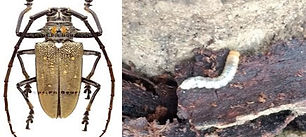
Mango
Crop Overview
Mango (Mangifera Indica) is the most ancient among the tropical fruits and believed to have originated in the Indo – Burma region. India is the major mango producing country in the world with an annual production of 8.50 million tonnes from an area of one million hectares. Mango is basically a tropical plant but endures wide range of temperature. It grows well under tropical and sub-tropical conditions. It gives profitable yield in semi-arid conditions, especially with irrigation.
Major Pests & Damage

Mango hoppers
(Idioscopus clypealis)

Mango mealy bug
(Drosicha mangiferae)

Mango Fruit fly
(Bactrocera (Dacus) dorsalis)

Thrips
(Scirtothrips mangiferae)

Mango stem borer
(Batocera rufomaculata)
Major Diseases

Anthracnose
(Colletotrichum gloeriosporides)
On mango, anthracnose symptoms occur on leaves, twigs, petioles, flower clusters (panicles), and fruits. On leaves, lesions start as small, angular, brown to black spots that can enlarge to form extensive dead areas. The lesions may drop out of leaves during dry weather.

Dieback
(Botryodiplodia theobromae)
The disease symptoms of dieback on mango are commonly associated with drying and withering of twigs from top downwards, followed by discoloration, drying and eventual dropping of leaves.

Mango Malformations
(Fusarium moniliformae and eriophid mites)
The most common symptom is abnormal, compact development of flowers and shoots. Both normal growth and growth affected by mango malformation disease may be present on the same tree.

Powdery Mildew
(Oidium mangiferae)
The characteristic symptom of the disease is the whitish, superficial, powdery fungal growth, mainly on inflorescences. Affected flowers do not open and in most cases, they shed prematurely. Young fruits may also be covered with powdery growth and drop off prematurely.
Major Diseases

Anthracnose
(Colletotrichum gloeriosporides)
On mango, anthracnose symptoms occur on leaves, twigs, petioles, flower clusters (panicles), and fruits. On leaves, lesions start as small, angular, brown to black spots that can enlarge to form extensive dead areas. The lesions may drop out of leaves during dry weather.

Dieback
(Botryodiplodia theobromae)
The disease symptoms of dieback on mango are commonly associated with drying and withering of twigs from top downwards, followed by discoloration, drying and eventual dropping of leaves.

Mango Malformations
(Fusarium moniliformae and eriophid mites)
The most common symptom is abnormal, compact development of flowers and shoots. Both normal growth and growth affected by mango malformation disease may be present on the same tree.

Powdery Mildew
(Oidium mangiferae)
The characteristic symptom of the disease is the whitish, superficial, powdery fungal growth, mainly on inflorescences. Affected flowers do not open and in most cases, they shed prematurely. Young fruits may also be covered with powdery growth and drop off prematurely.
Nutritional Deficiency

Boron

Zinc

Potassium

Iron











